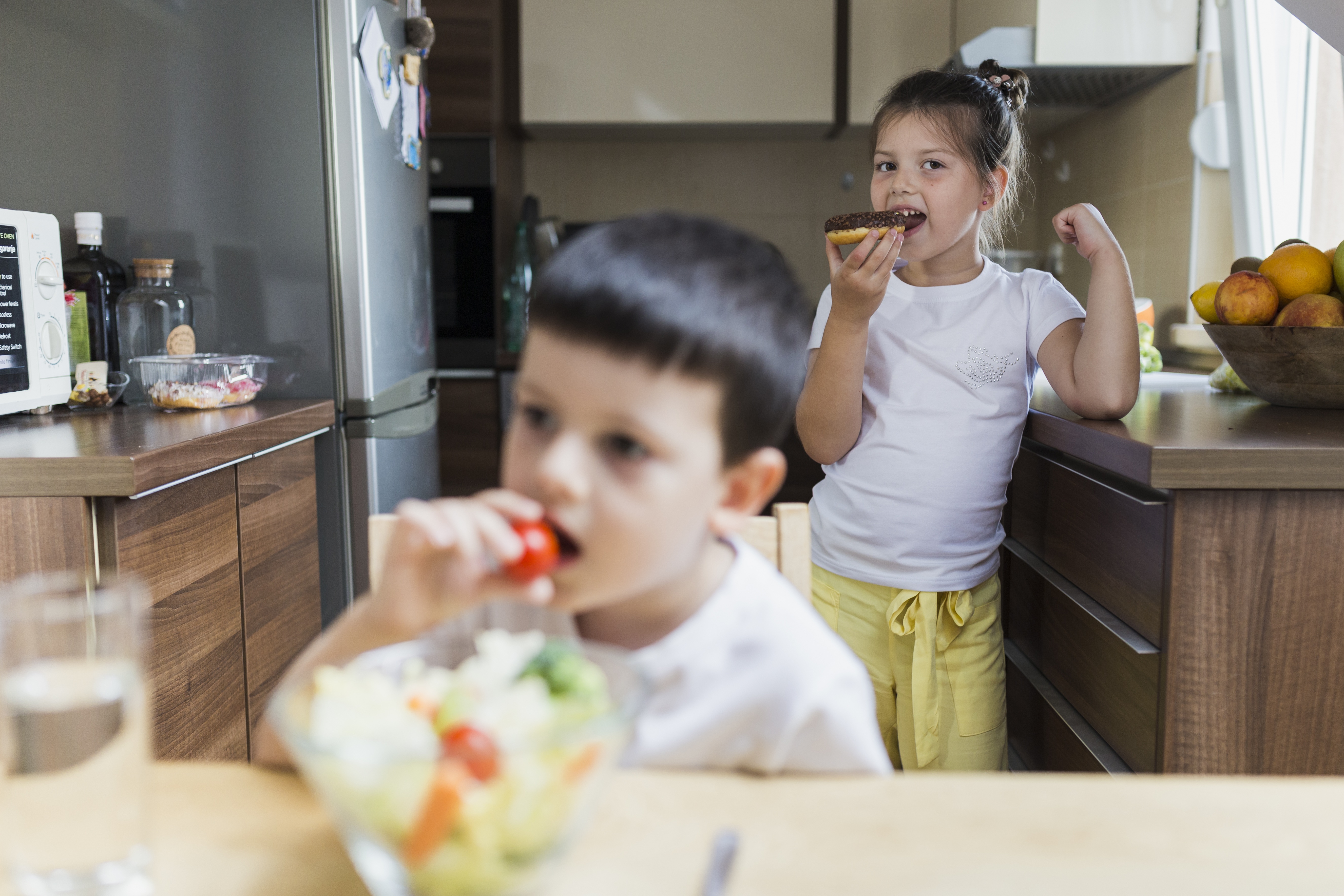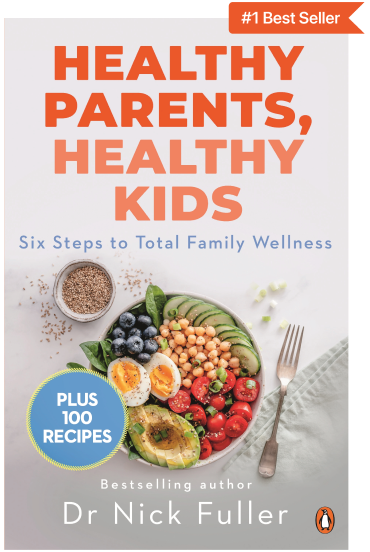Raising Busy Kids? Here’s Why Energy-Dense Foods for Kids Can Help

Dr Nick Fuller
Leading Obesity Expert at the University of Sydney and founder of Interval Weight Loss.

If your child is a fussy eater, constantly on the go, or struggles to keep up with growth spurts, energy-dense foods might be just what they need. These are foods that pack a lot of calories and nutrients into smaller portions, giving kids more fuel in every bite. Unlike low-calorie foods that fill little tummies too quickly, energy-dense options make it easier to meet children’s nutritional needs without overwhelming them with large volumes of food.
The Australian Bureau of Statistics shows that on average, toddlers aged 2–4 take in about 5,800 kJ a day, while teens can be closer to 9,300 kJ. And that’s just what’s reported. Real intakes are probably a bit higher. For highly active kids, athletes, or those with smaller appetites, hitting these targets can be challenging.
Energy-dense foods can bridge that gap between what kids eat and what their bodies actually need. A review highlights that diets including nutrient-rich, energy-dense foods not only support healthy growth and brain development but can also improve energy availability for children engaged in sports and active play.
In this article, we’ll explore what energy-dense foods are, why they matter for kids, and how to easily incorporate them into meals and snacks at home.
Worried About Kids Not Eating Enough? Learn How to Boost Energy Smartly!
When kids need more fuel but turn their noses up at food, mealtimes can feel impossible. That’s where Dr Nick Fuller’s Healthy Parents, Healthy Kids steps in. Packed with easy-to-apply strategies, this guide helps parents introduce energy-dense, nourishing foods in ways children actually enjoy, without battles or bribes.
Support your child’s growth and energy needs with confidence. Grab your copy of Healthy Parents, Healthy Kids today and learn how to fuel them the right way.
What Are Energy-Dense Foods?
Energy-dense foods are foods that pack a lot of kilojoules (calories) into a small serving. That means kids get more fuel from less food, which is a big win if they have small appetites, are fussy eaters, or are constantly on the move. Unlike low-calorie foods that can fill little tummies without providing enough energy, energy-dense choices deliver concentrated nutrition in every bite.
For growing bodies and busy brains, this extra fuel can make a real difference. Whether your child needs support with healthy weight gain, extra stamina for sports, or just steady energy to get through the school day, energy-dense foods can help meet their needs without overwhelming portion sizes.
According to studies, energy density depends heavily on factors like fat content (9 kcal/g) and water content (0 kcal/g). Foods with higher water content, such as vegetables or fruit, have lower energy density, which can help regulate appetite and overall intake. This evidence highlights how including more energy-dense foods can be a practical way to ensure children get enough calories and nutrients while still enjoying satisfying portions.
Why Energy-Dense Foods for Kids Matter
Kids burn through energy quickly. Between growing, learning, and endless play, their bodies need plenty of fuel to keep up. According to the Australian Dietary Guidelines, children’s energy needs vary depending on age, activity level, and growth stage.
Including energy-dense foods in your child’s diet can:
Support healthy growth and development
Energy-dense foods provide the calories and nutrients growing bodies need to develop properly. Protein, healthy fats, and essential vitamins help build strong muscles, bones, and tissues. Regularly including these foods ensures kids meet their daily nutritional requirements without struggling to eat large portions.
Provide sustained energy throughout the day
Kids need plenty of calories to keep up with school, play, and other activities. High-calorie, nutrient-rich foods spread throughout the day help make sure kids have enough fuel to stay active and engaged. Options like nuts, avocado, whole-grain bread, and cheese are easy to work into meals and snacks, giving children steady energy without overwhelming portions.
Help with healthy weight gain when needed
Some children, especially picky eaters or highly active kids, may need extra calories to maintain a healthy weight. Energy-dense foods offer a simple way to boost calorie intake without overwhelming them with large meals. This can support steady growth and ensure they are getting enough nutrients.
Improve focus and concentration in school
The brain relies on a steady supply of energy to function optimally. Energy-dense foods provide the nutrients needed for attention, memory, and learning. Foods like eggs, dairy, and fatty fish can help children stay engaged and perform better in class.
Boost physical performance in sports and play
Active kids need more calories to fuel movement, sports, and play. Energy-dense foods give them the endurance and strength required for physical activity. Snacks like trail mix, nut butter, or cheese can keep energy levels steady before and after sports.
Enhance nutrient intake with essential vitamins and minerals
Many energy-dense foods are also packed with key nutrients like iron, calcium, zinc, and B vitamins. These nutrients support everything from immunity to energy metabolism. By including these foods in daily meals, parents can improve overall diet quality for their kids.
Support brain development, thanks to healthy fats
Healthy fats found in foods like avocado, eggs, and fatty fish are crucial for brain growth and function. They aid in cognitive development, mood regulation, and learning abilities. Regularly offering these foods ensures kids get the building blocks their brains need.
Types of Energy Dense Foods
Here are some great examples of energy dense foods you can add to your child’s diet:
- Nuts – almonds, cashews, walnuts, peanuts
- Seeds – chia, sunflower, flax, pumpkin
- Nut butters – peanut, almond, cashew
- Avocado – creamy and nutrient-packed
- Cheese – a protein and calcium boost
- Full-fat yoghurt – opt for plain or Greek styles
- Whole milk – richer in calories than reduced-fat versions
- Cream – adds richness to meals
- Eggs – versatile and protein-rich
- Fatty fish – salmon, mackerel, sardines
- Chicken with skin – extra flavour and calories
- Red meat – iron-rich fuel
- Olive oil – drizzle for healthy fats
- Coconut oil – energy-boosting medium-chain fats
- Butter – adds calories and taste
- Ghee – clarified butter with a nutty flavour
- Dried fruits – raisins, dates, figs, apricots
- Bananas – easy energy on the go
- Granola – crunchy and calorie-dense
- Oats – hearty breakfast option
- Whole-grain bread – more filling than white bread
- Wraps and tortillas – great for portable meals
- Dark chocolate – a little treat with antioxidants
- Trail mix – the ultimate high-energy snack
Not sure which energy-dense foods to include in your child’s meals? Check out these High-Calorie Foods for Fussy Eaters. Perfect for growing bodies and busy brains.
Easy Ways to Sneak Energy-Dense Foods into Everyday Meals
Getting these foods into your child’s diet doesn’t have to be tricky. Here are some practical tips:
- Add nut butter to smoothies
- Mix seeds into yoghurt or oatmeal
- Spread avocado on toast or wraps
- Use olive oil when cooking or drizzling over veggies
- Top cereal or oatmeal with dried fruit and nuts
- Serve full-fat yoghurt instead of low-fat
- Add cheese to sandwiches, eggs, or pasta
- Make homemade trail mix for snacks
- Include eggs at breakfast or in baked dishes
- Blend a banana with whole milk for a quick drink
When to Give Energy-Dense Foods to Kids
Timing matters too. Here’s when energy dense foods can be most helpful:
- Breakfast – kick-start the day with oats, eggs, or yoghurt
- Mid-morning snack – trail mix, fruit with nut butter
- Lunch – sandwiches with cheese, wraps with avocado
- After-school snack – smoothie, granola bar, or dried fruit
- Pre-sports or activity snack – banana with peanut butter, yoghurt
- Dinner – fatty fish, chicken with skin, or pasta with olive oil
- Bedtime snack – warm milk, yoghurt with fruit, or wholegrain toast with nut butter
How Often Should You Give Energy-Dense Foods to Kids?
Energy-dense foods can be included every day as part of a balanced diet. Aim for:
- Daily in balanced portions – not too much, not too little
- With every main meal – to make sure each plate counts
- As 1 to 2 snacks per day – to keep energy levels steady
Final Thoughts
Energy-dense foods for kids are a powerful way to fuel growth, learning, and play without overwhelming little appetites. By including nutrient-rich, high-calorie foods in smart portions, parents can help children thrive, whether they need extra fuel for sports, support for steady growth, or just a little more balance in their daily meals. Try adding a few of the options above into your child’s routine. Small changes can make a big difference.
Stay ahead with current tips, professional advice, exclusive savings, and priority support!
Meet Dr Nick Fuller
My Story
As a father, I know first-hand that raising healthy and happy children is tricky. Children are fussy, particularly at the end of the day when they are shattered. We also live in a society where companies seek to profit from what we feed our kids; incorrect and damaging advice is pushed on us and marketed towards our children, and we have no time.
But with these recipes and resources, you and your children can enjoy simple and well-founded food and lifestyle choices for lifelong health.

About Dr Nick Fuller
Dr Nick Fuller is the founder of Interval Weight Loss and is a leading obesity expert at the University of Sydney with a Ph.D. in Obesity Treatment. Dr Fuller is also the author of three best-selling books and his work been published in top ranked journals in the medical field, including JAMA, Lancet and American Journal of Clinical Nutrition.
